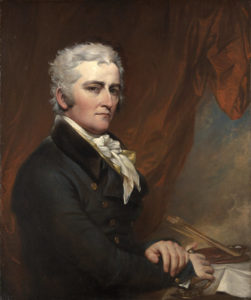 John Trumbull was born in 1756 in Lebanon, CT, the youngest of six children. His father was Jonathan Trumbull, an esteemed member of the Connecticut General Assembly. John developed a strong proclivity for drawing at a very early age. As a teenager he aspired to further develop his artistic skills under the tutelage of John Singleton Copley in Boston. His father, by then Governor of the Connecticut colony interceded however and John entered Harvard as law student.
John Trumbull was born in 1756 in Lebanon, CT, the youngest of six children. His father was Jonathan Trumbull, an esteemed member of the Connecticut General Assembly. John developed a strong proclivity for drawing at a very early age. As a teenager he aspired to further develop his artistic skills under the tutelage of John Singleton Copley in Boston. His father, by then Governor of the Connecticut colony interceded however and John entered Harvard as law student.
His graduation from Harvard in July 1773 coincided with the Boston Tea Party a few months later, protesting the unfair British tariffs on goods imported into the American colonies. Trumbull was inspired with the patriotic fervor prompted by this event, which kindled the American Revolution. He sought out military training, at first informally and then by officially joining the First Regiment of Connecticut in 1775. Two months later he witnessed the Battle of Bunker Hill which inspired his later work as a painter of battle field events.
After two years of military service, much of that time as the aide-de-camp to General George Washington, John Trumbull resigned from the military in 1777. He decided to rededicate himself to his artistic pursuits with the aim of creating paintings depicting key events in the American Revolution. In 1780 he became a student of the American painter Benjamin West in London, who had developed an artistic style known as “history painting”.
In November of 1780, just four months into his training with Benjamin West, news reached England of the hanging of Major John Andre, a British spy and collaborator with Benedict Arnold. In retribution for his former status as aide-de-camp to General Washington as well as being the son of the governor of Connecticut, Trumbull was imprisoned by the British. Upon his release eight months later he was deported to America.
In 1785, two years after the end of America’s War of Independence, Trumbull created his first history painting depicting The Death of General Warren at the Battle of Bunker Hill. In 1786, he returned to London where he created his most famous work The Declaration of Independence that depicted the members of the committee responsible for the drafting of the document in 1776. The painting is on permanent display in the United States Capitol rotunda.
To view the historical paintings by John Trumbull visit the Otis Library’s Flickr page on the library’s website.
